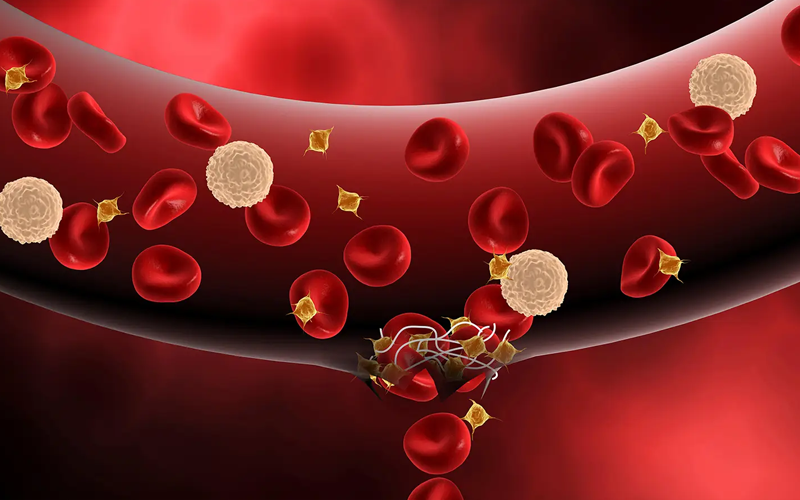Hemophilia: Causes, Types, Diagnosis And Treatment
Hemophilia is a condition where blood doesn’t clot properly because the body doesn’t make enough of certain substances needed for clotting. This happens because factors like VII, IX, and XI aren’t produced enough. Persons suffering from the disease regularly find hematomas on their bodies or encounter hemarthrosis, internal bleeding due to injuries or surgical interventions. Treatment of hemophilia in children is based on replacement therapy, which must be received throughout life.

Reasons for the development of pathology
X chromosome-related genes cause an inadequate generation of blood clotting proteins. Recessive inheritance of the disease occurs via the female line. Hereditary pathology only affects males. When a woman carries the gene for hemophilia, her sons have an equal chance of having hemophilia or not having it. It’s random whether they’ll show signs of the condition or not. A man suffering from bleeding disorders will be able to conceive healthy children with a woman who is not a carrier of the altered gene. There are a few known occurrences of hemophilia in women’s health. Men with low clotting factor production and moms with the gene for hemophilia cause the condition. It’s a mix of recessive and dominant genes that lead to hemophilia.
Classification of the Disease
Types of hemophilia are defined by the absence of a specific blood clotting factor in the patient’s body. Basic information regarding illness categories is provided below:
- Hemophilia A- It is diagnosed in 84-86% of people suffering from the pathology in question. Caused by a deficiency of clotting factor VIII (antihemophilic globulin).
- Hemophilia B- Occupies a share of 12-13% of clinically diagnosed cases of hemophilia. Develops against the background of deficiency of coagulation factor IX (thromboplastin)
- Hemophilia C- Occurs no more often than 1-2%. Becomes a consequence of insufficient production of blood coagulation factor XI.
About 0.5% of detected cases of hemophilia of various etiologies belong to other types – V, VII, X, and others.
Symptoms of hemophilia
The main symptom of hemophilia (whatever type it is) is prolonged blood loss, even after a slight external or internal trauma. Added to this are further symptoms, such as:
- Big, deep bruises
- Joint pain and swelling due to bleeding inside joints
- Unexplained bleeding and bruising
- Blood in urine, stool, or rectum
- Bleeding persistently following tooth loss
- Nosebleeds
- Irritability in babies
- Feeling very tired
It’s crucial to highlight that these symptoms don’t consistently appear in the same manner. This inconsistency stems from the extent of the deficiency in the coagulation factor associated with hemophilia, ultimately influencing the severity of the aforementioned manifestations.
Based on the amount of coagulation factor present, hemophilia can be divided into:
Mild: The amount of clotting factor is between 5 and 50% of normal. In this case, the disease does not cause particular problems except on a few occasions. For example, you notice that bleeding takes longer than usual when you first get seriously injured or after your first tooth extraction.
Moderate: the quantities of coagulation factor are very small (between 1 and 5% compared to the normal amount). The consequences of this condition are clear: the patient manifests, even in the presence of a modest trauma, extensive hematomas, long bleeding, and hemorrhages within the joints (hemarthrosis). The latter mainly affects the knees and ankles and causes pain, swelling, and a sense of joint stiffness.
Severe: The clotting factor dose is less than 1% of the normal amount. This form is characterized by the patient’s predisposition to spontaneous and severe bleeding without an obvious cause. The situation, in these cases, is critical.
Diagnosis of hemophilia
Looking into the family history for signs of bleeding problems when suspecting hemophilia. We use tests to check clotting factors, times for clotting, and other blood indicators to diagnose it.
- from 5 to 40% – light.
- from 1 to 5% – average.
- below 1% – severe.
Damage to a specific organ is determined using instrumental methods: ultrasound of joints, kidneys, abdominal organs, retroperitoneal space, urine analysis, blood tests, and coagulograms.
Severe forms are detected in early childhood, mild forms in adolescence, or even adulthood.
Treatment of hemophilia
Hemophilia doesn’t have a complete cure, but treatments like replacement therapy help. Medicines called clotting factor concentrates are key. Since hemophilia was included in the list of the “Seven Nosologies” program, drugs have become available not only for systematic treatment but also for prevention.
Before surgery, such patients are additionally given hemostatic agents of different groups: red blood cells, frozen plasma, hemostatic sponge, and thrombin.
Couples intending to conceive can proactively minimize the risk of hemophilia by undergoing genetic testing. Should conception occur, the option of amniocentesis allows for DNA diagnostics, ensuring early awareness. Expert care from a specialized hemophilia center from birth is crucial for a child’s well-being.
With long-term replacement therapy, plasmapheresis is recommended to remove formed antibodies. Nutrition should include a sufficient amount of phosphorus, calcium, and vitamins. A sick child should always have a special passport in an accessible place indicating the type of hemophilia, blood type, and Rh factor. Trauma should be avoided at all costs, as massive bleeding can lead to a tragic outcome.
Conclusion
If you or a loved one faces hemophilia, understanding its types, symptoms, and treatments is vital. Prompt diagnosis through lab tests and familial history evaluation guides effective management. Replacement therapy using clotting factor concentrates remains a cornerstone, easing symptoms and preventing complications. Regular care from specialized centers, dietary considerations, and cautiousness against trauma play crucial roles in living with this condition. Knowledge empowers you to navigate the challenges of hemophilia and ensure informed, proactive care.
If you Have Any Queries, Call Us On
+91-8193809030
